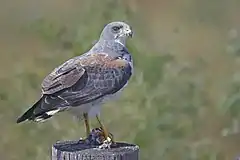| Geranoaetus[1] | |||
| Kaup, 1844[2] | |||
 Przedstawiciel rodzaju – aguja białosterna (G. albicaudatus) | |||
| Systematyka | |||
| Domena | |||
|---|---|---|---|
| Królestwo | |||
| Typ | |||
| Podtyp | |||
| Gromada | |||
| Podgromada | |||
| Infragromada | |||
| Rząd | |||
| Rodzina | |||
| Podrodzina | |||
| Plemię | |||
| Rodzaj |
Geranoaetus | ||
| Typ nomenklatoryczny | |||
|
Falco aguja Temminck, 1824 (= Spizaetus melanoleucus Vieillot, 1819) | |||
| Synonimy | |||
|
| |||
| Gatunki | |||
| |||
Geranoaetus – rodzaj ptaków z podrodziny jastrzębi (Accipitrinae) w rodzinie jastrzębiowatych (Accipitridae).
Zasięg występowania
Rodzaj obejmuje gatunki występujące w Ameryce (Stany Zjednoczone, Meksyk, Belize, Gwatemala, Honduras, Nikaragua, Kostaryka, Panama, Kolumbia, Trynidad i Tobago, Wenezuela, Gujana, Surinam, Gujana Francuska, Brazylia, Ekwador, Chile, Peru, Boliwia, Paragwaj, Argentyna i Urugwaj)[6].
Morfologia
Długość ciała 44–76 cm, rozpiętość skrzydeł 113–184 cm; masa ciała 865–3200 g[6].
Systematyka
Etymologia
- Geranoaetus: gr. γερανος geranos „żuraw” (tj. szary); αετος aetos „orzeł”[7].
- Tachytriorchis: gr. ταχυς takhus „szybki”; τριορχης triorkhēs „myszołów”, od τρεις treis, τρια tria „trzy”; ορχις orkhis „jądro”[8]. Gatunek typowy: Falco pterocles Temminck, 1821 (= Buteo albicaudatus Vieillot, 1816).
- Heteroaetus (Heteraetus): gr. ἑτερος heteros „różny, inny”; αετος aetos „orzeł”[9]. Gatunek typowy: Spizaetus melanoleucus Vieillot, 1819.
Podział systematyczny
Do rodzaju należą następujące gatunki[10]:
Uwagi
- ↑ Niepoprawna późniejsza pisownia Heteroaetus Kaup, 1845.
Przypisy
- ↑ Geranoaetus, [w:] Integrated Taxonomic Information System (ang.).
- ↑ Kaup 1844 ↓, s. 122.
- ↑ Kaup 1844 ↓, s. 123.
- ↑ J.J. Kaup. Ueber Falken. Mit besonderer Berücksichtigung der im Museum der Senckenbergischen naturforschenden Gesellschaft aufgestellten Arten. „Museum Senckenbergianum”. 3, s. 261, 1845. (niem.).
- ↑ J.J. Kaup. Coriglirte Uebersicht der Falconidae. „Archiv für Naturgeschichte”. 16 (1), s. 39, 1850.
- 1 2 D.W. Winkler, S.M. Billerman & I.J. Lovette: Hawks, Eagles, and Kites (Accipitridae), version 1.0. W: S.M. Billerman, B.K. Keeney, P.G. Rodewald & T.S. Schulenberg (red.): Birds of the World. Ithaca, NY: Cornell Lab of Ornithology, 2020. DOI: 10.2173/bow.accipi1.01. [dostęp 2020-06-06]. (ang.).

- ↑ The Key to Scientific Names ↓, Geranoaetus [dostęp 2022-02-02].
- ↑ The Key to Scientific Names ↓, Tachytriorchis [dostęp 2022-02-02].
- ↑ The Key to Scientific Names ↓, Heteroaetus [dostęp 2022-02-02].
- ↑ Systematyka i nazwy polskie za: P. Mielczarek & M. Kuziemko: Plemię: Accipitrini Vigors, 1824 (Wersja: 2021-10-27). [w:] Kompletna lista ptaków świata [on-line]. Instytut Nauk o Środowisku Uniwersytetu Jagiellońskiego. [dostęp 2021-12-28].
- ↑ M.J. Riesing, L. Kruckenhauser, A. Gamauf & E. Haring. Molecular phylogeny of the genus Buteo (Aves: Accipitridae) based on mitochondrial marker sequences. „Molecular Phylogenetics and Evolution”. 27 (2), s. 328–342, 2003. DOI: 10.1016/S1055-7903(02)00450-5. (ang.).
- ↑ F.S. Raposo do Amaral, M.J. Miller, L.F. Silveira, E. Bermingham & A. Wajntal. Polyphyly of the hawk genera Leucopternis and Buteogallus (Aves, Accipitridae): multiple habitat shifts during the Neotropical buteonine diversification. „BMC Evolution Biology”. 6, s. 10, 2006. DOI: 10.1186/1471-2148-6-10. (ang.).
- ↑ F.S. Raposo do Amaral, F.H. Sheldon, A. Gamauf, E. Haring, M. Riesing, L.F. Silveira & A. Wajntal. Patterns and processes of diversification in a widespread and ecologically diverse avian group, the buteonine hawks (Aves, Accipitridae). „Molecular Phylogenetics and Evolution”. 53 (3), s. 703–715, 2009. DOI: 10.1016/j.ympev.2009.07.020. (ang.).
- ↑ A. Kocum. Phylogenie der Accipitriformes (Greifvögel) anhand verschiedener nuklearer und mitochondrialer DNA-Sequenzen. „Praca doktorska”, s. 1–250, 2007. (ang.).
- ↑ H.R.L. Lerner, M.C. Klaver & D.P. Mindell. Molecular Phylogenetics of the Buteonine Birds of Prey (Accipitridae). „The Auk”. 304 (2), s. 304–315, 2008. DOI: 10.1525/auk.2008.06161. (ang.).
Bibliografia
- J.J. Kaup: Classification der Säugethiere und Vögel. Darmstadt: C. W. Leske, 1844, s. 1–144. (niem.).
- The Key to Scientific Names, J.A. Jobling (red.), [w:] Birds of the World, S.M. Billerman et al. (red.), Cornell Lab of Ornithology, Ithaca (ang.).
Identyfikatory zewnętrzne (takson monotypowy):
This article is issued from Wikipedia. The text is licensed under Creative Commons - Attribution - Sharealike. Additional terms may apply for the media files.